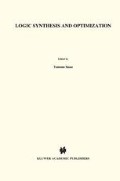Abstract
This paper proposes a new technology mapping method in which factorization and technology mapping are performed concurrently. The procedure works in three steps: factorization, cell selection and estimation of constraints. By taking the close relationship of these three steps into account, this method can accommodate detailed constraints because the information in the technology library is accessed during the mapping as well as during the factorization, and a circuit that satisfies given constraints can be synthesized.
Access this chapter
Tax calculation will be finalised at checkout
Purchases are for personal use only
Preview
Unable to display preview. Download preview PDF.
References
R. K. Brayton and C. T. McMullen and G. D. Hachtel and A. SangiovanniVincentelli, “Logic Minimization Algorithms for VLSI Synthesis”, Kluwer Academic Publishers U.S.A., 1984.
R. K. Brayton and C. T. McMullen, “The Decomposition and Factorization of Boolean Expressions”, Proc. of International Symp. on Circuit and Systems, 1982, pp. 49–54.
J.A. Darringer and D. Brand and J. V. Gerbi and W. H. Joyner,jr. and L. Trevillyan, “LSS: a system for production logic synthesis”, IBM J. Research and Development, 1984, Vol. 18, No. 5, pp. 537–545.
S. Muroga and Y. Kambayashi and H. C. Lai and J. N. Culliney, “The Transduction Method - Design of Logic Networks Based on Permission Functions,” IEEE Transactions on Computers, 1989, Vol. 38, No. 10, pp. 1404–1424.
R. K. Brayton and R. Rudell and A. Sangiovanni-Vincentelli and R. Wang, “MIS: A Multi-Level Logic Optimization System”, IEEE Transactions on Computer-Aided Design, 1987, Vol. CAD-6, No. 6, pp. 1062–1081.
E. Detjens and G. Gannot and R. Rudell and A. Sangiovanni-Vincentelli and A. Wang, “Technology Mapping in MIS”, Proc. of the ICCD, 1987, pp. 116–119.
A. J. deGeus and W. Cohen, “A Rule-Based System for Optimizing Combinational Logic”, IEEE Design and Test of computers, 1985, Vol. 2, No. 4, pp. 22–32.
K. Bartlett and W. Cohen and A. DeGeus and G. Hachtel, “Synthesis and Optimization of Multi-level Logic Under Timing Constraints”, Proc. of ICCAD, 1985, pp. 290–292.
D. Gregory and K. Bartlett and A. deGeus and G. Hachtel, “SOCRATES:A System for Automatically Synthesizing and Optimizing Combinational Logic”23rd Design Automation Conference, 1986, pp. 580–586.
K. Keutzer, “DAGON:Technology Binding and Local Optimization”, 24th Design Automation Conference, 1987, pp. 617–623.
R. Bryant, “Graph-Based Algorithms for Boolean Function Manipulation”, IEEE Transactions on Computers, 1986, Vol. C-35, No. 8, pp. 677–691.
H. J. Touati and H. Savoj and R. K. Brayton, “Delay Optimization of Combinational Logic Circuits by Clustering and Partial Collapsing”, Proc. of the ICCAD, 1991, pp. 188–191.
M. C. Lega, “Mapping Properties of Multi-Level Logic Synthesis Operations”, Proc. of the ICCD, 1988, pp. 257–261.
K-C. Chen and S. Muroga, “Timing Optimization for Multi-Level Combinational Networks”, 27th Design Automation Conference, 1990, pp. 339–344.
Author information
Authors and Affiliations
Editor information
Editors and Affiliations
Rights and permissions
Copyright information
© 1993 Springer Science+Business Media New York
About this chapter
Cite this chapter
Inamori, M., Takahara, A. (1993). A New Technology Mapping Method Based on Concurrent Factorization and Mapping. In: Sasao, T. (eds) Logic Synthesis and Optimization. The Kluwer International Series in Engineering and Computer Science, vol 212. Springer, Boston, MA. https://doi.org/10.1007/978-1-4615-3154-8_15
Download citation
DOI: https://doi.org/10.1007/978-1-4615-3154-8_15
Publisher Name: Springer, Boston, MA
Print ISBN: 978-1-4613-6381-1
Online ISBN: 978-1-4615-3154-8
eBook Packages: Springer Book Archive

